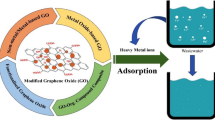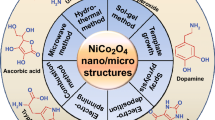Abstract
A nanocomposite consisting of β-cyclodextrin and chemically reduced graphene oxide (β-CD-rGO) was synthesized by chemical reduction of graphene oxide in the presence of β-CD. The morphology and structure of the nanocomposite were characterized using transmission electron microscopy, scanning electron microscopy, FTIR and Raman spectroscopy. The nanocomposite was cast onto a glassy carbon electrode to obtain a modified electrode. Due to its large surface area, fast electron transfer ability and the numerous functional groups of the composite, the modified electrode exhibits strong electrochemical response toward lead ion (Pb2+), as determined by differential pulse anodic stripping voltammetry. Under the optimal conditions, the stripping peak currents are linearly related to the concentrations of Pb2+ over the range from 1.0 to 100 nM. The limit of detection is 0.5 nM at a signal-to-noise ratio of 3. The modified electrode had been applied to the single-shot detection of Pb2+ in industrial waste water, and satisfactory results were obtained.

An inorganic-organic hybrid material of β-CD-rGO was synthesized by chemical reduction of graphene oxide in the presence of β-CD, which was applied as a high-performance platform for electrochemical determination of Pb2+.





Similar content being viewed by others
References
Wang MH, Zhang S, Ye ZH, Peng DL, He LH, Yan FF, Yang YQ, Zhang HZ, Zhang ZH (2015) A gold electrode modified with amino-modified reduced graphene oxide, ion specific DNA and DNAzyme for dual electrochemical determination of Pb(II) and Hg(II). Microchim Acta 182:2241–2249
Morante-Zarcero S, Sánchez A, Fajardo M, Hierro I, Sierra I (2010) Voltammetric analysis of Pb(II) in natural waters using a carbon paste electrode modified with 5-mercapto-1-methyltetrazol grafted on hexagonal mesoporous silica. Microchim Acta 169:57–64
Yilmaz V, Arslan Z, Rose LK (2013) Determination of lead by hydride generation inductively coupled plasma mass spectrometry (HG-ICP-MS): on-line generation of plumbane using potassium hexacyanomanganate(III). Anal Chim Acta 761:18–26
Beltrán B, Leal LO, Ferrer L (2015) Determination of lead by atomic fluorescence spectrometry using an automated extraction/pre-concentration flow system. J Anal At Spectrom 30:1072–1079
Zeng YX, Li SA, Sun F (2013) Simultaneous determination of heavy metals in strawberry by inductively coupled plasma atomic emission spectrometry (ICP-AES). Food Sci 34:204–207
Wang ZD, Lee JH, Lu Y (2008) Label-free colorimetric detection of lead ions with a nanomolar detection limit and tunable dynamic range by using gold nanoparticles and DNAzyme. Adv Mater 20:3263–3267
Zhu FX, Yang DY, Zhang XY (2003) Determination of lead in caleium propionate by flow injection chemiluminescence. Food Sci 24(8):119–121
Sokalski T, Zwickl T, Bakker E, Pretsch E (1999) Lowering the detection limit of solvent polymeric ion-selective electrodes. 1. Modeling the influence of steady-state ion fluxes. Anal Chem 71:1204–1209
Cui L, Wu J, Ju HX (2015) Electrochemical sensing of heavy metal ions with inorganic, organic and bio-materials. Biosens Bioelectron 63:276–286
Gadhari NS, Sanghavi BJ, Srivastava AK (2011) Potentiometric stripping analysis of antimony based on carbon paste electrode modified with hexathia crown ether and rice husk. Anal Chim Acta 703:31–40
Ghodbane O, Roué L, Bélanger D (2008) Study of the electroless deposition of Pd on Cu-modified graphite electrodes by metal exchange reaction. Chem Mater 20:3495–3504
Wen Y, Pei H, Wan Y, Su Y, Huang Q, Song S, Fan C (2011) DNA nanostructure-decorated surfaces for enhanced aptamer-target binding and electrochemical cocaine sensors. Anal Chem 83:7418–7423
Pumera M, Ambrosi A, Bonanni A, Chng ELK, Poh HL (2010) Graphene for electrochemical sensing and biosensing. TrAC Trends Anal Chem 29:954–965
Liu J, Fu S, Yuan B, Li Y, Deng Z (2010) Toward a universal “adhesive nanosheet” for the assembly of multiple nanoparticles based on a protein-induced reduction/decoration of graphene oxide. J Am Chem Soc 132:7279–7281
Liang GD, Zheng LM, Bao SP, Gao HY (2015) Graphene-induced tiny flowers of organometallic polymers with ultrathin petals for hydrogen peroxide sensing. Carbon 93:719–730
Jabbarzadeh F, Siahsar M, Dolatyari M, Rostami G (2015) Fabrication of new mid-infrared photodetectors based on graphene modified by organic molecules. IEEE Sensors J 15:2795–2800
Wei Y, Gao C, Meng FL, Li HH, Wang L, Liu JH, Huang XJ (2012) SnO2/reduced graphene oxide nanocomposite for the simultaneous electrochemical detection of cadmium(II), lead(II), copper(II), and mercury(II): an interesting favorable mutual interference. J Phys Chem C 116:1034–1041
Gao F, Zheng DL, Tanaka H, Zhan FP, Yuan XN, Gao F, Wang QX (2015) An electrochemical sensor for Gallic acid based on Fe2O3/electro-reduced graphene oxide composite: estimation for the antioxidant capacity index of wines. Mater Sci Eng C 57:279–287
Freeman R, Finder T, Bahshi L, Willier I (2009) β-cyclodextrin-modified CdSe/ZnS quantum dots for sensing and chiroselective analysis. Nano Lett 9:2073–2076
Yang YZ, Gao F, Cai XL, Yuan XN, He XY, Gao F, Guo HX, Wang QX (2015) β-cyclodextrin functionalized graphene as a highly conductive and multi-site platform for DNA immobilization and ultrasensitive sensing detectionBiosens. Biosens Bioelectron 74:447–453
Durán GM, Contentoa AM, Ríos A (2015) A continuous method incorporating β-cyclodextrin modified CdSe/ZnS quantum dots for determination of ascorbic acid. Anal Methods 7:3472–3479
Yang L, Zhao H, Li CP, Fan SM, Li BC (2015) Dual β-cyclodextrin functionalized Au@ SiC nanohybrids for the electrochemical determination of tadalafil in the presence of acetonitrile. Biosens Bioelectron 64:126–130
Badruddoza AZM, Shawon ZBZ, Wei JDT (2013) Fe3O4/cyclodextrin polymer nanocomposites for selective heavy metals removal from industrial wastewater. Carbohydr Polym 91:322–332
Hummers WS, Offeman RE (1958) Preparation of graphitic oxide. J Am Chem Soc 80:1339
Guo YJ, Guo SJ, Ren JT, Zhai YM, Dong SJ, Wang EK (2010) Cyclodextrin functionalized graphene nanosheets with high supramolecular recognition capability: synthesis and host-guest inclusion for enhanced electrochemical performance. ACS Nano 4:4001–4010
Huang KJ, Liu YJ, Wang HB, Gan T, Liu YM, Wang LL (2014) Signal amplification for electrochemical DNA biosensor based on two-dimensional graphene analogue tungsten sulfide-graphene composites and gold nanoparticles. Sensors Actuators B Chem 191:828–836
Ye XL, Du YL, Lu DB, Wang CM (2013) Fabrication of β-cyclodextrin-coated poly (diallyldimethylammonium chloride)-functionalized graphene composite film modified glassy carbon-rotating disk electrode and its application for simultaneous electrochemical determination colorants of sunset yellow and tartrazine. Anal Chim Acta 779:22–34
Agnihotri N, Chowdhury AD, De A (2015) Non-enzymatic electrochemical detection of cholesterolusing β-cyclodextrin functionalized grapheme. Biosens Bioelectron 63:212–217
Abdolmohammad-Zadeh H, Talleb Z (2015) Magnetic solid phase extraction of gemfibrozil from human serum and pharmaceutical waste water samples utilizing a β-cyclodextrin grafted grapheme oxide-magnetite Nano-hybrid. Talanta 134:387–393
Gao C, Yu XY, Xu RX (2012) AlOOH-reduced graphene oxide nanocomposites: one-pot hydrothermal synthesis and their enhanced electrochemical activity for heavy metal ions. ACS Appl Mater Interfaces 4:4672–4682
WHO (2004) WHO guidelines for drinking-water quality, 3rd edn. WHO, Geneva, pp. 392–394
Li Z, Chen L, He F, Bu LJ, Qin XL (2014) Square wave anodic stripping voltammetric determination of Cd2+ and Pb2+ at bismuth-film electrode modified with electroreduced graphene oxide-supported thiolated thionine. Talanta 122:285–292
Zhou WS, Li CH, Sun C, Yang XD (2016) Simultaneously determination of trace Cd2+and Pb2+ based on l-cysteine/graphene modified glassy carbon electrode. Food Chem 192:351–357
He XH, Su ZH, Xie QJ, Chen C (2011) Differential pulse anodic stripping voltammetric determination of Cd and Pb at a bismuth glassy carbon electrode modified with nafion, poly(2,5-dimercapto-1,3,4-thiadiazole) and multiwalled carbon nanotubes. Microchim Acta 173:95–102
Pan DW, Wang YN, Chen ZP, Lou TT, Qin W (2009) Nanomaterial/ionophore-based electrode for anodic stripping voltammetric determination of lead: an electrochemical sensing platform toward heavy metals. Anal Chem 81:5088–5094
Acknowledgments
The work is supported by the National Natural Science Foundation of China (No. 21275127), Education-Scientific Research Project for Young and Middle-aged Teachers of Fujian (No. JA15305, JA15314), and Program for New Century Excellent Talents in Fujian Province University (No. JA12204).
Author information
Authors and Affiliations
Corresponding author
Ethics declarations
The author(s) declare that they have no competing interests
Rights and permissions
About this article
Cite this article
Zhan, F., Gao, F., Wang, X. et al. Determination of lead(II) by adsorptive stripping voltammetry using a glassy carbon electrode modified with β-cyclodextrin and chemically reduced graphene oxide composite. Microchim Acta 183, 1169–1176 (2016). https://doi.org/10.1007/s00604-016-1754-2
Received:
Accepted:
Published:
Issue Date:
DOI: https://doi.org/10.1007/s00604-016-1754-2




